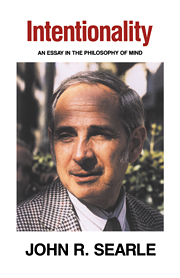Book contents
- Frontmatter
- Contents
- Acknowledgements
- Introduction
- 1 The nature of Intentional states
- 2 The Intentionality of perception
- 3 Intention and action
- 4 Intentional causation
- 5 The Background
- 6 Meaning
- 7 Intensional reports of Intentional states and speech acts
- 8 Are meanings in the head?
- 9 Proper names and Intentionality
- 10 Epilogue: Intentionality and the brain
- Subject index
- Name index
- Frontmatter
- Contents
- Acknowledgements
- Introduction
- 1 The nature of Intentional states
- 2 The Intentionality of perception
- 3 Intention and action
- 4 Intentional causation
- 5 The Background
- 6 Meaning
- 7 Intensional reports of Intentional states and speech acts
- 8 Are meanings in the head?
- 9 Proper names and Intentionality
- 10 Epilogue: Intentionality and the brain
- Subject index
- Name index
Summary
Intentional states with a direction of fit have contents which determine their conditions of satisfaction. But they do not function in an independent or atomistic fashion, for each Intentional state has its content and determines its conditions of satisfaction only in relation to numerous other Intentional states. We saw this in the case of the man who forms the intention to run for the Presidency of the United States. He would normally believe, for example, that the United States is a republic, that it has periodic elections, that in these elections the candidates of two major parties vie for the Presidency, and so on. And he would normally desire that he receive the nomination of his party, that people work for his candidacy, that voters cast votes for him, and so on. Perhaps no one of these is essential to the man's intention, and certainly the existence of none of them is entailed by the statement that the man has the intention to run for the Presidency of the United States. Nonetheless, without some such Network of Intentional states the man could not have formed what we would call “the intention to run for the Presidency of the United States”. We might say that his intention ‘refers’ to these other Intentional states in the sense that it can only have the conditions of satisfaction that it does, and thus can only be the intention that it is, because it is located in a Network of other beliefs and desires.
- Type
- Chapter
- Information
- IntentionalityAn Essay in the Philosophy of Mind, pp. 141 - 159Publisher: Cambridge University PressPrint publication year: 1983



